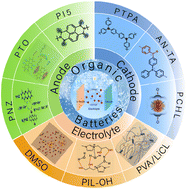Research progress and perspectives on ultra-low temperature organic batteries
Abstract
Traditional lithium ion batteries (LIBs) will lose most of their capacity and power at ultra-low temperatures (below −40 °C), which to a large extent limits their applications in new energy vehicles, national defense security, space exploration and deep-sea operations and other high-tech fields. Benefiting from the structural designability and excellent low temperature performance of organic materials, ultra-low temperature organic batteries are considered as a promising ultra-low temperature energy storage technology, which has achieved rapid development in the past decade. In this review, we systematically summarize the recent advances in the development of ultra-low temperature organic batteries. To begin with, three different structural characteristics and the corresponding energy storage mechanisms of ultra-low temperature organic batteries are described. The next major section deals with the exciting progress related to the electrolytes and electrode materials of aqueous and non-aqueous ultra-low temperature organic batteries. Finally, the challenges and future development of ultra-low temperature organic batteries are also suggested.

- This article is part of the themed collection: Journal of Materials Chemistry A Recent Review Articles


 Please wait while we load your content...
Please wait while we load your content...